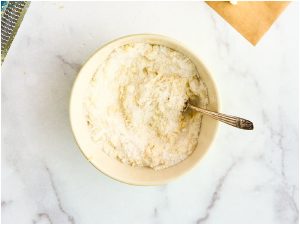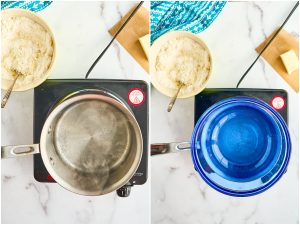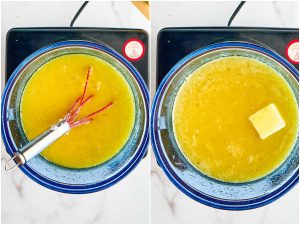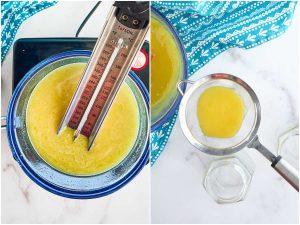Small Batch Lemon Curd
A simple but perfect blend of eggs, sugar, butter, and lemon. Perfect for layering in between cake and spreading on biscuits.
Equipment
- Zester (or Microplane)
- Citrus juicer
- Mixing bowl
- Whisk
- Double boiler
- Thermometer
- fine mesh strainer (optional)
- Spatula
- Mason jars (half-pint size)
Ingredients
- ¼ cup lemon zest (about 6 lemons worth)
- 1 ¼ cups granulated sugar
- 4 egg yolks
- 2 whole eggs
- ¼ cup lemon juice (about 4 lemons worth)
- 3 tablespoons unsalted butter
Instructions
- Mix the zest and sugar. In a medium bowl, combine the lemon zest and sugar. Set aside for 30 minutes to allow the flavors to infuse.

- Prepare the double boiler. Fill a saucepan with about 1 inch of water and place it over medium-low heat. Allow the water to come to a gentle simmer. Then, place a heatproof bowl or the top of a double boiler over the simmering water, making sure the bottom of the bowl doesn’t touch the water.

- Combine the ingredients. Whisk together the egg yolks and whole eggs in the heatproof bowl until well blended. Then, add the lemon juice and the sugar-zest mixture. Continue stirring, then slowly add the butter, one tablespoon at a time, allowing each piece to melt before adding the next.

- Cook to 170°F. Stir the mixture constantly over the simmering water until it thickens and reaches 170°F on a thermometer. Using the thermometer is important, as the texture won’t visibly change much during cooking.
- Strain (optional). Remove the bowl from the heat. If you like a smoother curd, use a fine mesh strainer to remove the zest and egg solids. This step is optional for those who like more texture.

- Cool and store. Stir the curd for about 5 minutes as it cools, which will help it thicken further. Pour the lemon curd into sterilized half-pint mason jars, leaving about ½ inch of space at the top if freezing.
Canning Instructions
- Sterilize the jars. Wash your mason jars and lids with warm, soapy water, and rinse well. Then, sterilize them by boiling the jars and lids in water for 10 minutes. Keep them hot until you’re ready to use them.
- Fill the jars. Pour the hot lemon curd into the sterilized jars, leaving about ½ inch of space at the top. Then, wipe the rims clean to make sure they have a proper seal.
- Seal the jars. Place the lids on the jars and screw on the bands until they are fingertip tight.
- Process in a water bath. Place the filled jars into a water bath canner or a large pot with a rack. Add enough water to cover the jars by at least 1 inch, and heat the water to 180°F (not boiling). Once the water reaches a rolling boil, process the jars for 15 minutes. If you live at a higher elevation, adjust the processing time according to local guidelines.Processing times are:- 15 minutes for sea level- 20 minutes for 1000 ft- 6000 ft elevations- 25 minutes for 6000+ elevations
- Cool the jars. Remove the jars carefully and set them on a towel for 12–24 hours. Once cooled, check that the lids have sealed properly by pressing the center of each lid. If it doesn’t pop back, the jar is sealed.
- Store. Store the sealed jars in a cool, dark place for up to 2 months.
Notes
Make sure your eggs are at room temperature. Cold eggs won’t mix as well and can make your mix lumpy. Leave your eggs out for about 30 minutes before you start for a smoother mix.
If you want your curd to be smooth, don’t forget to strain it. Running it through a mesh sieve helps catch any zest or bits of egg that weren’t thoroughly mixed in.
Since lemons can be more or less sour, add some extra sugar if yours is on the tart side. This is especially helpful if you like your curd sweeter.
Be mindful of the type of bowl and whisk you use. Lemon juice can react with metal and give your curd a weird, metallic taste. It’s best to use glass, ceramic, or stainless steel for your bowl and a silicone or wooden whisk.
Let your curd cool down for around 10–15 minutes before putting it in jars. Putting it in too hot can cause water to build up in the jar, making your curd runny.
You can make your curd sweeter if needed by mixing in more sugar while still warm. Just don’t overdo it, or it might mess up the texture.
Once you’ve finished making lemon curd, play around with it. Try adding some vanilla extract, or use a bit of lime, orange, or grapefruit juice instead of lemon for a twist.
Servings: 1 pint